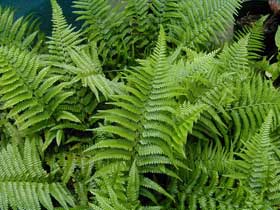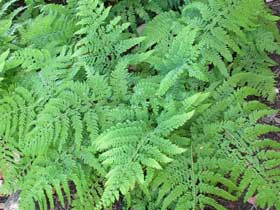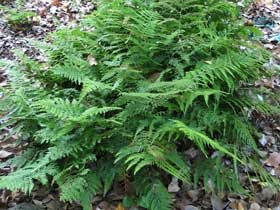Microlepia strigosa var. strigosa
Genus
Microlepia
Species
strigosa
Varieties
- strigosa
Hawaiian Names with Diacritics
- Palai
- Palapalai
Hawaiian Names
- Palai
- Palapalai
Common Names
- Hay-scented fern
- Lace fern
- Rigid lace fern
Synonyms
- Davallia hirta
- Davallia setosa
- Davallia strigosa
- Dicksonia kaulfussiana
- Dicksonia strigosa
- Microlepia hirta
- Microlepia setosa
- Stenoloma tenuifolium
- Trichomanes strigosum
Distribution Status
Indigenous
Endangered Species Status
No Status
Plant Form / Growth Habit
- Non-Woody, Spreading
Mature Size, Height (in feet)
- Fern/Fern-like, Tall, Greater than 3
Mature Size, Width
Palapalai is known to have a 3- to 5-foot spread.
Life Span
Long lived (Greater than 5 years)
Landscape Uses
- Accent
- Container
- Ground Cover
- Indoor
Additional Landscape Use Information
A beautiful native fern that is easy to grow and maintain in a landscape in part sun locations with sufficient moisture. Does well under large trees or shrubs as a high groundcover to hide fallen leaves in its thick lush undergrowth. [David Eickhoff, Native Plants Hawaiʻi]
Clumps increase in size reasonably quickly. [1]
Palapalai does well as an indoor plant and can even be used in a bathroom. [4]
Palapalai is sometimes available in garden stores. Ask for the source, since a similar fern from the Mainland also is often sold under the name Palapalai. [1]
Source of Fragrance
- Leaves
Additional Fragrance Information
The leaves, or fronds, have a hay scent and thus aptly given the vernacular name of Hay-scented fern, not to be confused with another fern Dennstaedtia punctilobula, which also goes by the same name.
Plant Produces Flowers
No
Plant texture
- Coarse
Additional Plant Texture Information
Fronds can grow to more than 3 feet long.
Leaf Colors
- Light Green
- Medium Green
Additional Leaf Color Information
Palapalai fronds are pale green and somewhat hairy.
Additional Pest & Disease Information
Caterpillars will occasionally chew on palapalai fronds.
Fertilizer
Palapalai appreciate a 13-13-13 slow release fertilizer every six months for plants in pots. For larger potted ferns showing poor color or not producing crosiers (fiddleheads or emerging fronds), use a complete fertilizer at half the recommended strength. Do not till solid fertilizers into soil because the ferns have a shallow root system. [Kay Lynch, Lāʻau Hawaiʻi]
Pruning Information
Dead fronds may need to be removed. Cut, do not pull off, dead fronds.
Water Requirements
- Moist
Additional Water Information
While not drought tolerant, palapalai can grow in somewhat dry or moist conditions. But plants prefer moist, not waterlogged, soil. [1]
Soil must be well drained
Yes
Light Conditions
- Full sun
- Partial sun
Additional Lighting Information
Palapalai does poorly in hot, exposed sites. [1] Plants can tolerate full sun, but performs best and looks nicer with some shade. Best suited for cooler mauka sites. [1]
Spacing Information
These ferns should be spaced between 1 to 3 feet apart, but can be planted closer together to control weeds.
Soils
- Cinder
- Organic
Limitations
Possibly salt spary tolerate, [7] but this needs to be confirmed.
Palapalai is sensistive to herbicides. [1] Be cautious about herbicide drift on breezy days when applying to nearby plants.
Natural Range
- Kauaʻi
- Oʻahu
- Molokaʻi
- Lānaʻi
- Maui
- Hawaiʻi
Natural Zones (Elevation in feet, Rainfall in inches)
- Less than 150, 0 to 50 (Dry)
- Less than 150, 50 to 100 (Mesic)
- 150 to 1000, 0 to 50 (Dry)
- 150 to 1000, 50 to 100 (Mesic)
- 1000 to 1999, 0 to 50 (Dry)
- 1000 to 1999, 50 to 100 (Mesic)
- 2000 to 2999, 0 to 50 (Dry)
- 2000 to 2999, 50 to 100 (Mesic)
- 3000 to 3999, 0 to 50 (Dry)
- 3000 to 3999, 50 to 100 (Mesic)
- 4000 to 4999, 0 to 50 (Dry)
- 4000 to 4999, 50 to 100 (Mesic)
Additional Habitat Information
Palapalai grows mostly in dry to moderately wet habitats near sea level to over 5,800 feet.
![]() Special Features and Information
Special Features and Information
General Information
Palapalai is a highly variable fern belonging to a worldwide group of about seventy Microlepia species in the Bracken or Hay-scented fern family (Dennstaedtiaceae). [2] There are two indigenous species and a hybrid found in the main Hawaiian Islands.
The most famous family member is the bracken fern (Pteridium aquilinum), known as kīlau in the Hawaiian Islands, which is perhaps the worlds most common fern.
An extremely hairy endemic variety Microlepia strigosa var. mauiensis (syn. Microlepia mauiensis) is uncommon to rare in mesic to wet forests in the Waiʻanae Mountains of Oʻahu, West and East Maui, and Hawaiʻi Island. Hawaiʻi Botanist Joel Lau notes of its range on Oʻahu that he has "seen it in three locations: West Makaleha, Mākaha, and Palikea."
The less common relative, Microlepia speluncae, known as Limpleaf fern, is very similar in appearance but usually has larger, sometimes much larger, fronds. Picking the fronds is a quick way to determine the species. The fronds of M. speluncae soon go limp after being picked, whereas M. strigosa do not. [2] Too, at close examination or just by touch, M. strigosa has small bristlelike (Latin, striga) hairs on leaves; whereas M. speluncae do not (glabrous).
There is also a hybrid between the Microlepia speluncae x M. strigosa that has given the interesting Latin name Microlepia x adulteriana. [2] The name implies an adulterous relationship between the two parental species. The hybrid forms large colonies where the two species are found together.
Etymology
The generic name Microlepia is derived from the Greek mikros, small, and lepis, scale, alluding to the small cuplike indusia (spore covering) of this genus.
The specific epithet strigosa is from the Latin strigosus, bristles or stiff hairs, in reference to the tiny rigid hairs on the fronds of this species.
Background Information
In its native habitat and in artificial landscapes, palapalai does well against invading weeds or other plants under 3 feet tall.
Early Hawaiian Use
Hula:
Early Hawaiians used the fronds to decorate hula altars dedicated to Laka, goddess of hula. [1]
Lei:
These ferns were used by early Hawaiians as head lei (lei poʻo), neck lei (lei ʻāʻī), and wrist lei (lei kūpeʻe). Palapalai was commonly used with other lei materials and also to provide a soft base against the skin of the wearer. [5,9]
Medicinal:
The plants were used as psycological aid for insanity. [6] It can also be used to bathe in. The slimyleaf fronds were fed to babies. [7]
Song (Chant):
Palapalai is often mentioned in song (mele) and chant.
Modern Use
This fern continues to be an essential part of lei work today much as it was by early Hawaiians. The fronds are used for lei encircling the head, wrist, and ankles of hula dancers. Every spring before the Merry Monarch Dance Festival in Hilo, Hawaiʻi Island, hula hālau gather palapalai for hula kahiko (ancient hula). While collecting the fronds does not in itself damage the populations, tredding in the area can be locally distruptive to native groundcovers in the koa/aʻe/ʻōhiʻa forests. [8]
Palapalai is grown in many gardens in the islands and used as a high groundcover or for traditional uses.
Additional References
[1] "How to Plant a Native Hawaiian Garden" by Kenneth M. Nagata, page "Palapalai."
[2] http://homepages.caverock.net.nz/~bj/fern/microlepia.htm [accessed 10/16/09]
[3] http://plants.usda.gov/java/profile?symbol=MISP2
[4] "Container Gardening in Hawaii" by Janice Crowl, page 53.
[5] "Nā Lei Makamae--The Treasured Lei" by Marie A. McDonald & Paul R. Weissich, pages 131-132.
[6] "Hawaiian Herbs of Medicinal Value," by D.M. Kaaiakamanu & J.K. Akina, page 73.
[7] "Native Hawaiian Medicine--Volume III" by The Rev. Kaluna M. Kaʻaiakamanu, page 83.
[8] "Hawai'i's Plants and Animals--Biological Sketches of Hawaii Volcanoes National Park" by Charles P. Stone & Linda W. Pratt, page 259.
[9] "Lāʻau Hawaiʻi: Traditional Hawaiian Uses of Plants" by Isabella Aiona Abbott, page 127.
PHOTOS FOR THIS SPECIES CAN BE SEEN AT THE LINK (Copy & Paste to your browser):
https://www.flickr.com/search/?user_id=50823119%40N08&sort=date-taken-desc&view_all=1&text=Microlepia%20strigosa%20var.%20strigosa
Plant Gallery
Back to Plant List
Other Nursery Profiles for Microlepia strigosa var. strigosa



